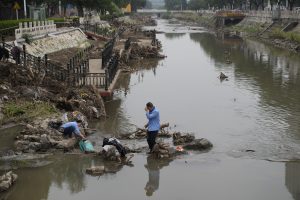The death toll from recent flooding in China’s capital rose to 33, including five rescuers, and another 18 people are missing, officials said Wednesday, as much of the country’s north remains threatened by unusually heavy rainfall.
Days of heavy rain hit areas in the city’s mountainous western outskirts especially hard, causing the collapse of 59,000 homes, damage to almost 150,000 others and flooding of more than 15,000 hectares (37,000 acres) of cropland, according to the city government.
Scores of roads were damaged, along with more than 100 bridges, Xia Linmao, a Beijing vice mayor, said at a news conference on Wednesday.
The casualty and damage numbers were current as of Tuesday, Xia said, adding that rescue efforts remained underway. Given the level of damage, it could take up to three years to restore full functions, Xia said. The area, which includes the districts of Mentougou and Fanshan, are kilometers (miles) away from the city center, where the nation’s leaders live and many of its top administrative and business centers are located.
Other parts of China have also seen heavy flooding, partly from the impact of Typhoon Doksuri over the weekend, leaving dozens dead and missing. Hebei province just outside Beijing has seen some of the region’s worst flooding. Floodwaters in Zhuozhou, southwest of Beijing, started to recede Saturday, allowing some of the 125,000 evacuated residents to return to their homes.
Flooding in Hebei has been particularly controversial, with reports from local villages that officials are deliberately channeling floodwaters into the area to spare Beijing – and especially the Xiong’an New Area, a development project championed by top leader Xi Jinping. Video clips posted online purported to show police and government officials working to destroy dykes protecting Zhuozhou and other villages near Beijing.
Outrage grew after the Chinese Communist Party secretary for Hebei said the province he is responsible for governing should “resolutely serve as a moat” to protect Beijing. China’s minister of water resources also drew criticism for singling out Xiong’an New Area and Beijing’s new airport as priorities for relief efforts.
Heavy rains have battered northern China since late July, disrupting the lives of millions.
A rescue operation was also underway in the tourist resort of Ya’an in the southwestern province of Sichuan, where about a dozen visitors were swept away by rushing waters, according to the official Xinhua News Agency. The bodies of seven victims were recovered, while four people were rescued, and rescuers were still looking for others, the agency said.
Meanwhile, other areas are suffering from scorching summer heat and drought, threatening people’s heath and the autumn harvest. More than 5,000 firefighters were battling some 15 wildfires in the sprawling Inner Mongolia region in the country’s far north on the border with Russia and the independent nation of Mongolia.
Earlier, six people died and four went missing in the city of Shulan in the northeastern province of Jilin, which experienced five straight days of rainfall, turning streets into rivers and forcing the evacuation of tens of thousands. Heilongjiang province to the north has also seen rivers overflow their banks.
China’s deadliest and most destructive floods in recent history were in 1998, when 4,150 people died, most of them along the Yangtze River.
In 2021, more than 300 people died in the central province of Henan. Record rainfall inundated the provincial capital of Zhengzhou on July 20 that year, turning streets into rushing rivers and flooding at least part of a subway line.

































